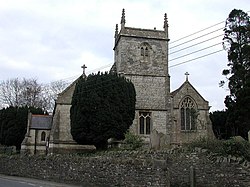High Littleton
| High Littleton | |
| Somerset | |
|---|---|
 Holy Trinity Church | |
| Location | |
| Grid reference: | ST645583 |
| Location: | 51°19’21"N, 2°30’31"W |
| Data | |
| Population: | 2,104 (2011) |
| Post town: | Bristol |
| Postcode: | BS39 |
| Dialling code: | 01761 |
| Local Government | |
| Council: | Bath & NE Somerset |
| Parliamentary constituency: |
North East Somerset |
High Littleton is a village in the north of Somerset, on the A39 and A37 roads eight miles from Bath, ten miles from Bristol and twelve miles from Wells. The wider civil parish (including the hamlets of Hallatrow and Amesbury) has a population of 2,104. It is in the county's Chewton Hundred. Nearby are villages including Clutton, Temple Cloud and Timsbury.
There is a Church of England Voluntary Controlled Primary School (4–11 years) in the village, several pubs and shops.
Church
The parish church is dedicated to the Holy Trinity and is an ancient stone edifice with a tower. It contains monuments of the Mogg and Hodge families dating back to the 15th century. On 15 July 1310 the advowson of the church at High Littleton was given to the abbey by Gilbert Aumery, and Bishop Drokensford sanctioned its appropriation by the abbey in 1322, but the royal licence is dated 1328. In 1322 the bishop approved the appropriation of the church of High Littleton to Keynsham, because of the losses which the abbey had sustained in the floods, rain, and murrain in its lands in Ireland and Wales, and in its loss of the tithes of Chewstoke.[1]
The church is now run by the vicar of Holy Trinity Church, Paulton creating the joint benefices of Paulton, High Littleton and Farrington Gurney, due to the vicar of High Littleton retiring.
The church is a Grade II listed building, with monuments in the churchyard listed themselves.[2]
History
There is evidence of settlement at High Littleton since Anglo-Saxon times in the late 7th or 8th century. Its name is the Old English Lytel tun meaning just 'little village'.
The manor is listed in the 1086 Domesday Book as Liteltone. The property was owned by the Bishop of Coutances and sub-let to a tenant named as Ralph Rufus.[3]
Mining and Geology
Coal mines were established in the villages by 1633 because on the Somerset coalfield the coal seams ran obliquely to the surface. The first deep mine in the parish was Mearns Coalworks which began in 1783.
During the 1790s William Smith worked extensively in the area as a mine surveyor and as chief surveyor for the Somersetshire Coal Canal; and it was during this time that he formulated his ideas of rock stratification.[4] He describes the area as the 'birthplace of geology'.[5]
By 1800 the population had grown to about 800; however, many of these may have worked in mines outside the parish. The Greyfield Coal Company did not start until 1833. It received a boost with the opening of the Bristol and North Somerset Railway in 1873. Greyfield Colliery closed in 1911 and the railway in 1964.
Transport
Hallatrow railway station was an important station on the Bristol and North Somerset Railway, and the junction for the branch line to Camerton, which opened in 1882 and which was later extended eastwards along the line of the Somersetshire Coal Canal to a junction at Limpley Stoke with the line from Bath Spa station to Bradford-on-Avon.
In addition to its role as a junction, Hallatrow was also an important goods depot, receiving milk from local farms, printed materials from Purnells' factory at Paulton and local coal.
The station closed when the Bristol and North Somerset line closed to passenger traffic in 1959; goods services were withdrawn in 1964 and the last train ran in 1968.
About the village
The parish has several fine houses still existing. High Littleton House was built by Thomas Hodges around 1710.[6][7] The Grange, in Hallatrow is dated 1669.[8]
Outside links
| ("Wikimedia Commons" has material about High Littleton) |
- High Littleton & Hallatrow History and Parish Records
- High Littleton Parish Council
- Map of High Littleton circa 1900
References
- ↑ "'Houses of Augustinian canons: The abbey of Keynsham', A History of the County of Somerset: Volume 2 (1911), pp. 129-32". http://www.british-history.ac.uk/report.asp?compid=40930. Retrieved 5 March 2006.
- ↑ National Heritage List 1320760: Church of Holy Trinity
- ↑ Robinson, Stephen (1992). Somerset Place Names. Wimborne, Dorset: The Dovecote Press Ltd. ISBN 1-874336-03-2.
- ↑ Chapter 5, The Map That Changed the World, by Simon Winchester, publ 2001 Chivers Press, ISBN 0-7540-1626-9
- ↑ www.highlittletonhistory.org.uk Retrieved 16 October 2013
- ↑ National Heritage List 1136525: High Littleton House
- ↑ Nikolaus Pevsner: Pevsner Architectural Guides
- ↑ National Heritage List 1129567: The Grange